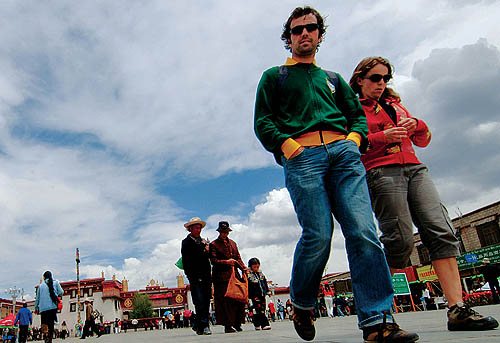|

Tibet is richly endowed with tourism resources. Its varied topography is composed largely of the Himalayas mountainous area, northern Tibet plateau lake area, and eastern Tibet high mountain valley area. Its landscape features grassland, wetlands, lakes, river valleys, forests, highland glaciers, snow-capped peaks, geothermal fields and others. The region boasts more than 50 peaks each with a height of more than 7,000 meters, and five over 8,000 meters. They include the number one peak in the world, Qomolangma. The area is the source of four major rivers in Asia and also has three lakes each covering an area of over 1,000 square km, making the region number one in China in this regard. Tibet's forests and living timbers rank fifth and first in China, with the forest coverage rate reaching 9.8 percent.
In addition, Tibet boasts three world-class nature reserves (Qomolangma Nature Reserve, Northern Tibet Changtang Nature Reserve, and Eastern Tibet Yarlung Zangbo Grand Canyon Nature Reserve), and one State-class scenic area (Yarlung State Class Scenic Area). Its natural scenery includes snowy mountainous areas centered on the Himalayas, a grassland scenic area centered on the northern Tibet Changtang Grasslands, natural scenic area centered on the eastern Tibet forests and gorges, and highland lake and mountain scenic area centered on holy mountains and holy lakes in Ngari. Nam Co is representative of grassland lakes and Basum Co is representative of the highland forest lakes.
Tibet has a long history and rich culture. It boasts some 1,600 well preserved and well managed monasteries full of valuable classics. Its rich folklore gives birth to five areas of cultural interest: (1) A political, economic, religious, historical and cultural center represented by the Potala Palace and Jokhang Monastery in Lhasa; (2) Tibetan cultural cradle area represented by Shannan's Yongbulakang, Samye Monastery, Qamzhub Monastery, and Tombs of the Tibetan Kings; (3) Religious cultural area presented by Xigaze's Tashilhungpo Monastery and Sagya Monastery; and (4)Cultural relics area represented by the "ruins of the Guge Kingdom Capital" in northwest Tibet; and (5)Historical and cultural area represented by the "tea-horse trade route" saturated with the Kham culture of Qamdo.
Tibet has three world-class cultural heritages—the Potala Palace, the Jokhang Monastery and the Norbu Lingka; three State-class historical and cultural cities, referring to Lhasa, Xigaze and Gyangze; one 5A scenic area which is the Potala Palacep; four 4A scenic areas, namely Potala Palace, Jokhang Monastery, Norbu Lingka, Museum and Basum Co Lake; one State outstanding tourist city, Lhasa; some 2,000 cultural relics units subject to regional-level protection, and 35 cultural relics units subject to national protection, and 168 cultural relics units subject to county (city) level protection. Tibet has opened a "golden triangle" historical, religious and cultural scenic area encompassing Lhasa-Xigaze-Gyangze. There is the plan to extend the route to Ngari in northern Tibet and areas in southeast Tibet. |
